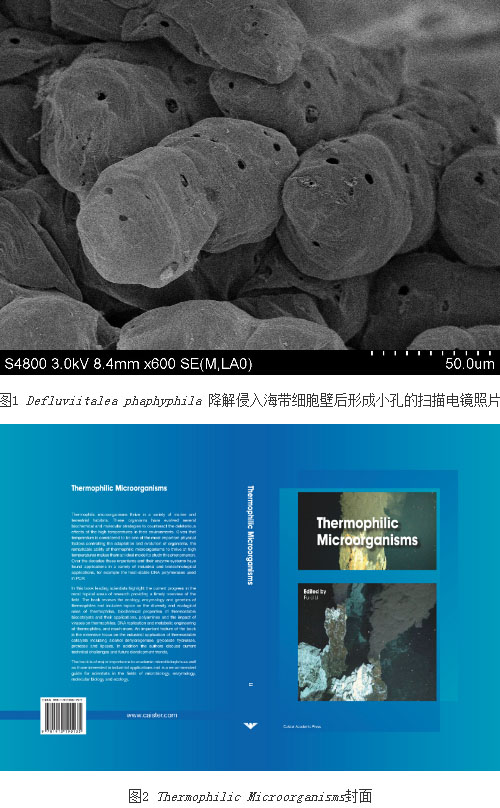
The marine thermophiles are widely present in high-temperature anaerobic environments such as deep-sea craters, hydrothermal fluids, and oil and gas fields. The special living environment of thermophiles provides good materials for microbial physiology, evolution, ecological research and industrial applications. The team led by Li Welfare, a researcher at the Institute of Bioenergy and Bioprocess Research of the Chinese Academy of Sciences in Qingdao, has been focusing on the study of thermophilic microorganisms in recent years.
The team found that thermophilic bacteria not only exist in high-temperature environments such as oil and gas fields and craters, but also have abundant thermophilic resources under the near-shore low-temperature marine environment. Brown algae is an important class of marine primary producers, and plays an important role in CO2 absorption and near-shore carbon cycle, and its degradation mechanism has attracted much attention. The team's associate researcher Miao Shiqi and others isolated a large number of new species of thermophiles from the marine environment. Among them, Defluviitalea phaphyphila can efficiently ferment 12 g/L of ethanol from brown algae with a conversion rate of 0.25. Through genomic analysis and key enzyme characterization, the strain was found to have a complete system for degradation and utilization of brown algae (alginate, mannitol, and laminarin). The related results were recently published online in Applied and Environmental Microbiology (Ji et al, 2016, doi: 10.1128 /AEM.03297-15; Figure 1). The alginate degradation pathway contains several alginate lyases with high-temperature enzyme activities. Compared with the previously reported alginase, these enzymes have higher catalytic efficiency and excellent thermal stability. Enzymatic degradation of alginate is mild and green, and the natural unsaturated configuration and biological activity of oligosaccharides can be maintained during the enzyme degradation process. It has advantages in the production of oligosaccharides and has great industrial application prospects. At the same time, the study found a different way of mannitol metabolism than the traditional way.
Li Welfare was recently invited to edit the book Thermophilic Microorganisms, which was officially published by Caister Academic Press (Figure 2). The book contains the thermophilic microbial diversity, thermostable biocatalysts, thermophilic viruses, DNA replication, and metabolic engineering. The book was prepared by experts from relevant fields such as Canada, China, Germany, Japan, and the United States.
The above research was supported by the National Natural Science Foundation of China, the Outstanding Youth Fund of Shandong Province, the Director's Innovation Fund, and the Shandong Provincial Science and Technology Development Plan.
MONEL®
The registered trademark name, Monel, is applied as the prefix name to several corrosion resistant alloys produced by Special Metals Corporation. These alloys are nickel-based and exhibit traits that include high resistance to atmospheric corrosion, salt water, and various acid and alkaline solutions.
Alloys of identical chemical and mechanical properties are available from other manufacturers and offer excellent alternatives to the various Monel® brand alloys.
The corrosion-resistant alloy is widely used in the marine, oil and chemical processing industries.
Monel Availability
Mega Mex supplies Monel 400, K-500 & R-405. Most of these grades are available in the form of plate, sheet, pipe, tubing, fittings, bar, wire and rod.
What are the Characteristics of Monel ?
Good resistance to acids such as hydrofluoric and sulfuric acid
Highly resistant to alkalis
Malleable
Highly corrosion resistant
Stronger than steel
In what Applications are Monel alloys used ?
Pump shafts, oil-well tools, instruments, doctor blades and scrapers, springs, valve trim, fasteners, marine propeller shafts
Marine components
Chemical and hydrocarbon processing equipment
Valves, pumps, shafts, fittings, heat exchangers
Monel Trivia
Monel was discovered by Robert Crooks Stanley who worked for the International Nickel Company in 1901. The new alloy was named in honor of the president of the company, Ambrose Monell.
*Monel® is a registered trademark of Special Metals Corporation group of Companies.
Monel Pipe,Monel 400 Pipe,Monel Steel Pipe
YUHONG HOLDING GROUP CO.,LIMITED , https://www.alloypipeline.com
